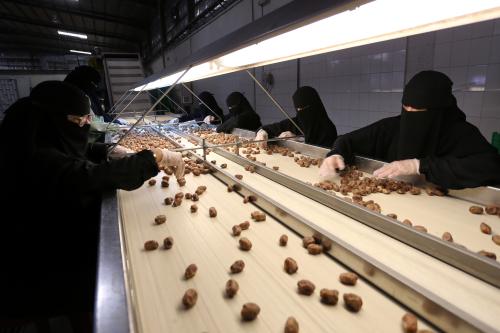A previous blog showed the remarkable rise of Saudi female labor force participation over the last three years. In this blog, we want to look at what might explain this strong increase. Our analysis shows that the many reforms of the past years are likely to have played a substantial role, but that some of the increase—especially during the crisis—might have been circumstantial.
Research from other countries has indicated that policy—alongside better education for women and structural changes in the economy—plays a major role in explaining increases in female labor force participation. In the Organization for Economic Cooperation and Development (OECD) countries, the strongest expansion in the labor force participation of prime-aged women happened between 1980 and 2000 with an average increase of 12 percentage points. Most of this expansion can indeed be explained by the aforementioned factors.
Over the past few years, the Saudi Arabian government has made significant reforms to incentivize women to find employment and to protect them better on the job. These reforms also increased Saudi Arabia’s score in the World Bank Women, Business, and Law (WBL) database by almost 50 points (Figure 1) between 2016 and 2020. In parallel, female labor force participation rates improved at unprecedented rates, rising by 14 percentage points during the same time.
Areas of reforms include: allowing greater freedom of movement (travel abroad, having a passport, driving, and moving residences); forbidding gender-based discrimination in employment; abolishing requirement for segregation in the workplace; eliminating restrictions on women’s employment in industrial jobs, jobs that were deemed dangerous, and in jobs that require a night shift; making it easier for women to have their own businesses; forbidding the dismissal of women from jobs for maternity- or pregnancy-related reasons; equalizing retirement age between men and women; prohibiting gender-based discrimination in accessing financial services; and criminalizing sexual harassment in public and private sector workplaces.
Other reforms that are bearing fruit include expanding access to education for all Saudi women. In fact, Saudi women do better than Saudi men in the formal education system and have 7 percent higher enrollment in universities. Also, Saudi women strongly benefited from the expansion of the service sector in recent years. An explicit “Saudization” policy that incentivizes hiring of Saudi over expatriate workers has surely contributed to this development. As a result, in 2020, 26 percent of Saudi women worked in the wholesale and retail sector.
These reforms were indeed substantial and have made a major contribution to improving labor market outcomes for Saudi women, however, it is unlikely that they explain the full extent of the increase in women’s labor force participation rates in 2020—a year that was marked by the unfortunate departure of many women from the labor market in most countries of the world.
While it is still early to provide definite answers, there is indication from recent data that Saudi women may have taken some of the jobs held by expatriate workers who left the country in the wake of the pandemic. Driven by major outflows of expatriate workers during the second and third quarters of 2020, it looks like female employment experienced some boost in sectors where expatriate employment was hardest hit (Figure 2). It seems that employers turned toward Saudi women to replace some of the missing expatriate workers when the economy reopened during the third quarter of 2020, particularly in sectors such as wholesale and retail, construction, manufacturing, and administrative and support service activities. However, this compensation is only partial and the Saudi economy is yet to recover from the unprecedented decline in the number of expatriate workers in the country.
Some Saudi women seem to be closer substitutes to expatriate workers than Saudi men. While both Saudi men and Saudi women are still paid, on average, more than twice the amount that expatriate workers receive, Saudi women are more willing to work at lower wages compared to men. Saudi men are paid 2.7 times the amount that expatriate workers receive. As for Saudi women, they are paid 2.2 times that amount.
Hence, the recent gains in Saudi women’s employment and labor force participation seem to be the result of a combination of past policy reforms and the circumstances of the pandemic, with the latter perhaps being a catalyst. An open question is how sustainable this will be in the future. In the past, the evidence was clear that there was not much substitution between Saudi and non-Saudi workers: Just like in other countries, there is little substitution in the labor market between natives and migrants. If this latest surge was driven by a temporary shortage of expatriate workers, it might evaporate in the future. Sustaining these large gains may require going further and addressing long-standing distortions that have kept the demand for Saudi labor low in the private sector, chief among them the large differences in wages and employment conditions between Saudis and non-Saudis, as well as gaps in the country’s training and skills development policies. Many further reforms to address these challenges are currently underway, like the abolishment of the kafala system and the introduction of free mobility for expatriate workers. Only time will tell if these and other reforms can sustain the gains made so far, or even expand on them.







Commentary
Why are Saudi women suddenly starting to take jobs?
May 19, 2021